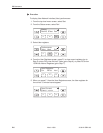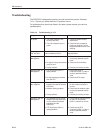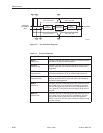
Maintenance
4-11
3160-A2-GB21-80
March 1999
Alarms
The DSU/CSU can be attached, either locally or remotely, to an ASCII terminal or
printer to display or print alarm messages. Alarms can also be displayed on a PC
that is using a terminal emulation package.
For standalone DSU/CSUs, you can route these alarms to the MODEM port, the
COM port, or both. For carrier-mounted DSU/CSUs, you can route them to the
COM port or dial them out using an external device.
Each alarm message contains a customer identification to indicate which remote
DSU/CSU is reporting an alarm. For information about customer identification,
refer to
Displaying Unit Identity
in Chapter 3,
Operation
.
Possible alarm messages are as follows:
H Continuous Loss Of Signal detected at the
x
Interface
(where
x
is either Network or DTE).
H Alarm Cleared. Loss Of Signal condition at the
x
Interface (where
x
is either Network or DTE).
H Continuous Out Of Frame condition detected at the
x
Interface (where
x
is either Network or DTE).
H Alarm Cleared. Out Of Frame condition at the
x
Interface
(where
x
is either Network or DTE).
H Alarm Indication Signal received at the
x
Interface (where
x
is either Network or DTE).
H Alarm Cleared. Alarm Indication Signal at the
x
Interface
(where
x
is either Network or DTE).
H An Excessive Error Rate has been detected at the Network
Interface.
H Alarm Cleared. An Excessive Error Rate at the Network
Interface.
H Yellow Alarm signal received at the
x
Interface (where
x
is
either Network or DTE).
H Alarm Cleared. Yellow Alarm signal at the
x
Interface
(where
x
is either Network or DTE).
H Continuous Out Of Frame condition detected at synchronous
data port
n
(where
n
is the port number).
H Alarm Cleared. Out Of Frame condition at synchronous data
port
n
(where
n
is the port number).
H An Excessive Error Rate has been detected at synchronous
data port
n
(where
n
is the port number).
H Alarm Cleared. An Excessive Error Rate at synchronous
data port
n
(where
n
is the port number).


















